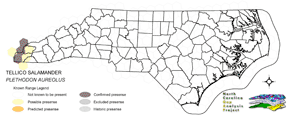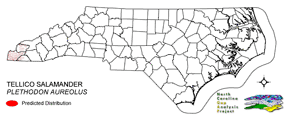|
| | | | | | | | | | |
 |
| |
|
Tellico salamander
|
|
| Plethodon aureolus
|
| |
| ITIS Species Code: 208280
NatureServ Element Code: AAAAD12250
|
|
| |
| |
Amphibia | | Caudata | | Plethodontidae
|
| | NatureServe Global Rank: | |
NatureServe State (NC) Rank: | | |
| | | Federal Status: | |
NC State Status: | | |
| |
|
|
|
| |
| HEXAGONAL KNOWN RANGE: | PREDICTED DISTRIBUTION: |
 |
 |
|
|
|
| |
| SUMMARY OF STATEWIDE PREDICTED DISTRIBUTION: |
| | | | Land Unit |
| | US Fish & Wildlife Service | | US Forest Service | | US National Park Service
| | US Department of Defense | | NC State Parks | |
NC University System | | NC Wildlife Res. Com. | | NC Forest Service | |
NC Div. of Coastal Mgmt. | | Local Governments | | Non-Governmental Org. | |
Other Public Lands | | Private Lands |
| | GAP Status 1-2
| | All Protected Lands | | Statewide |
|
| | | Hectares |
| |
0.00 | | 6,454.98 | | 6.66 | |
660.06 | | 0.00 | | 0.00 | |
0.00 | | 0.00 | | 0.00 | |
0.00 | | 0.00 | | 0.00 | |
18,199.44 |
| | 926.19 | | 7,115.04
| | 25,321.14
| | | | | Acres |
| |
0.00 | | 15,950.60 | | 16.46 | |
1,631.04 | | 0.00 | | 0.00 | |
0.00 | | 0.00 | | 0.00 | |
0.00 | | 0.00 | | 0.00 | |
44,971.79 |
| | 2,288.66 | | 17,581.64
| | 62,569.89
|
| | % of Dist. on |
| Prot. Lands |
| |
0.0 % | | 90.7 % | |
0.0 % | | 9.3 % | |
0.0 % | | 0.0 % | |
0.0 % | | 0.0 % | |
0.0 % | | 0.0 % | |
0.0 % | | 0.0 % | |
0.0 % |
| | 13.0
% | | ----- | | ----- |
|
| % of Dist. on | | All Lands |
| |
0.0 % | | 25.5 % | |
< 0.1 % | | 2.6 % | |
0.0 % | | 0.0 % | |
0.0 % | | 0.0 % | |
0.0 % | | 0.0 % | |
0.0 % | | 0.0 % | |
71.9 % |
| | 3.7
% | | ----- | | ----- |
|
|
|
|
|
|
|
|
|
|
| |
| HABITAT DESCRIPTION: |
| |
Occurs on lower slopes and in lowlands on and around the Unicoi mountain range on the border of North Carolina and Tennessee (Wilson 1995). It is found in shaded stream valley woodlands and adjacent uplands within its limited range (Redmond and Scott 1996). Both deciduous and coniferous forests are used, but deciduous stands appear to be
preferred (Wilson 1995). Highest abundances have been found in the vicinity of bottomlands with an abundance of leaf litter, rotting logs and an organic soil layer (Wilson 1995). Eggs are deposited on land under logs or litter (Wilson 1995).
|
|
| |
| MODELING DESCRIPTION: |
| Occupied Landcover Map Units: |
| | Code |
Name | Description |
NC Natural Heritage Program Equivalent |
| 230 | Piedmont Mesic Forest
|
American Beech - Red Oak - White Oak Forests.
|
Mesic Mixed Hardwood
|
| 384 | Piedmont/Mountain Mixed Bottomland Hardwood Forests
|
Includes temporarily to seasonally forests dominated by hardwood species. Hardwoods include sweetgum, red maple, sycamore which co-occur in a mosaic of bottomland and levee positions. Includes alluvial hardwood forests in the mountains. Hemlock and white pine may occur as inclusions, but are generally mapped separately.
|
Piedmont/Mountain Alluvial Forest, Piedmont/Mountain Levee Forest
|
| 517 | Hemlock Floodplain Forest
|
Alluvial forest with hemlock and/or white pine in mountains and western piedmont. Hydrology is generally temporarily to seasonally flooded.
|
Canada Hemlock Forest
|
| 522 | Northern Hardwoods
|
High Elevation forests including yellow birch, American beech, and yellow buckeye. Includes forests with Hemlock and Yellow Birch.
|
Northern Hardwoods Forest, Boulderfield Forest
|
| 525 | Appalachian Oak Forest
|
A variety of oak forest types including Black, White, Scarlet Oaks in dry to mesic situations. Includes forests historically co-dominated by American Chestnut.
|
High Elevation Red Oak Forest, Montane White Oak Forest
|
| 526 | Appalachian Cove Forest
|
Mixed Mesophytic forests of the mountains. Includes tuliptree, basswood, yellow buckeye and surgar maple. This class is mapped to include cove forests dominated or co-dominated by hemlock.
|
Rich Cove Forest, Acidic Cove Forest
|
| 527 | Appalachian Hemlock
|
Upland hemlock forests of the moutains region. Vary from side slopes to steep slope positions.
|
Canada Hemlock Forest
|
|
| View Entire Landcover Legend |
| |
|
Additional Spatial Constraints: |
| Exclude all area outside of known range. |
| Limited to elevation range: less than
2500 ft. |
| |
| CITATIONS: |
|
Carr, D. E. 1996. Morphological variation among species and populations of salamanders in the PLETHODON GLUTINOSUS complex. Herpetologica 52:56-65.
Wilson, L. A. 1995. The Land Manager's Guide to the amphibians and reptiles of the South. Chapel Hill, NC: The Nature Conservancy.
Highton, R. 1986. PLETHODON AUREOLUS. Catalogue of American Amphibians and Reptiles 381:1.
Highton, R., G. C. Maha, and L. R. Maxson. 1989. Biochemical evolution in the slimy salamanders of the PLETHODON GLUTINOSUS complex in the eastern United States. Illinois Biological Monographs 57:1-153.
|
|
|
| 10 March 2005 |
| |
This data was compiled and/or developed
by the North Carolina GAP Analysis Project.
For more information please contact them at:
NC-GAP Analysis Project
Dept. of Zoology, NCSU
Campus Box 7617
Raleigh, NC 27695-7617
(919) 513-2853
www.basic.ncsu.edu/ncgap |


